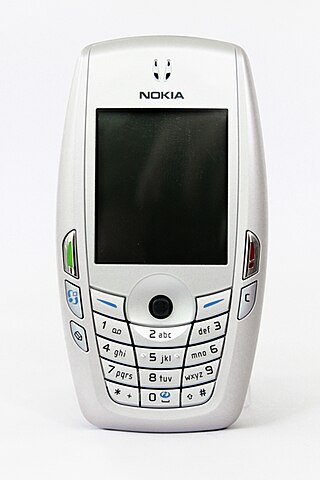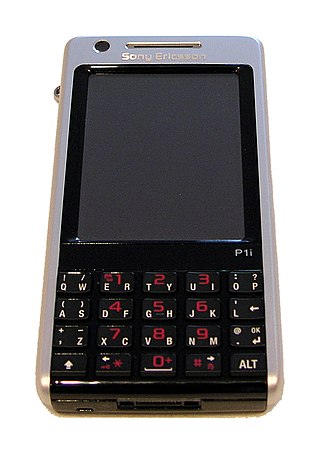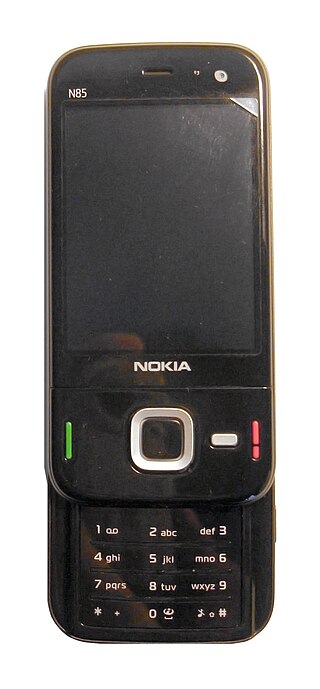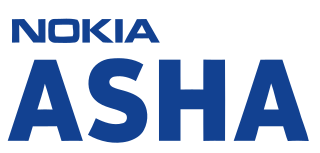
The 6620 is a mobile phone created by Nokia, announced in 2005, running on Series 60 2nd Edition and the Symbian operating system. It was the first EDGE-capable phone for the Americas' market.

The Nokia 6230 is a mobile phone based on the Nokia Series 40 platform. It was announced on 28 October 2003 and released in February 2004.

The Nokia 9210 Communicator is a third-generation Communicator series mobile phone produced by Nokia, announced on 21 November 2000 and released in June 2001. It greatly improved on the second generation Nokia 9110 Communicator, providing a colour main screen and using an ARM processor. It is one of the few mobile phones able to send and receive fax.

The Nokia 6600 is a mobile phone introduced on 16 June 2003 by Nokia, costing approximately €600 when released in October 2003. It was part of Nokia's high-end model of the 6xxx Classic Business Series. It runs on Symbian OS 7.0s. It also featured a VGA camera, a music player and video player, Bluetooth and a memory card slot, being the second non-Communicator to do so.

A mobile phone feature is a capability, service, or application that a mobile phone offers to its users. Mobile phones are often referred to as feature phones, and offer basic telephony. Handsets with more advanced computing ability through the use of native code try to differentiate their own products by implementing additional functions to make them more attractive to consumers. This has led to great innovation in mobile phone development over the past 20 years.

The Nokia 6111 is a mid-level GSM mobile phone released in June 2005. It sold in Asia, Europe, Australia, Brazil and in Mexico, but was not taken by any carriers in the United States.

The Sony Ericsson P1 is a mobile phone and the successor of the P990. It was the last of the Sony Ericsson "P" Smartphone series, introduced in 2002 with the Sony Ericsson P800 and it integrates many of the hardware features of its predecessor the P990 in the form factor of the M600. It was announced on 8 May 2007. There is a Chinese version of P1 called P1c. Compare with P1/ P1i, P1c lacks of 3G, thereby using EDGE which is much slower but more available especially in the US and parts of Europe.
The Nokia 6000 series or Classic Business series is range of mobile phones marketed by Nokia. This family of phones is notable for their conservative, unisex designs, making them popular with business users.

The Nokia 6070 is a mobile phone made by Nokia. It operates on GSM tri band frequency 900, 1800 and 1900 MHz, with automatic switching between frequencies. It is small in size with dimensions of 105.4 x 44.3 x 18.6 mm and weights 88 grams. It was released in the second quarter of 2006. The phone runs using Nokia S40 second edition. The features include a VGA camera, FM radio and voice recording.
The Nokia 6800 series are a selection of Nokia Series 40 phones with an unusual fold-out QWERTY keyboard. This type of keyboard is also used in the more recent Nokia Series 60 Symbian-based Nokia E70. These phones were marketed as "messaging devices": all had built-in email clients, and some had BlackBerry support.
The Nokia 7650 is a 2.5G consumer-oriented mobile phone belonging to the fashion and experimental (7xxx) series. It was introduced in Barcelona on 19 November 2001, and was described by CEO Jorma Ollila as the company's most important launch of that year.

The Nokia E71 is a mobile phone introduced on 8 May 2008 from the Eseries range with a QWERTY keyboard targeting business users worldwide. It runs on Symbian OS v9.2, with a Series 60 3rd Edition, second generation Feature Pack 1. The Nokia E71 succeeded the Nokia E61/61i models, building on the base design and form factor but enhancing on the feature set.
The Nokia 6210 Navigator is a mobile phone made by Nokia that is a successor to Nokia 6110 Navigator. It was announced on February 11, 2008 and had been available from July 2008. It runs on Symbian OS v9.3 with a S60 3rd Edition FP2 user interface.

The Nokia E63 is a mobile phone announced on 12 November 2008 and released later that year. It is based on Symbian's S60 software platform and is considered a budget business smartphone positioned below the Nokia E71, featuring a plastic body instead of metal. Many of the specifications are identical to the E71 except for the lack of GPS and infrared, a lesser RAM, lack of HSDPA and lower-resolution camera with a fixed-focus lens. The E63 does come with a flashlight function using the camera flash, which is not present in the E71. It also has a more standardized 3.5 mm audio jack whereas the E71 uses a 2.52 mm jack as used on older Nokia phones. The E63 retailed for about 199 euros before taxes. The device was succeeded by the Nokia E5, but remain in production until its discontinuation in late 2011 in favour of Nokia's Lumia lineup.

The Nokia N85 is a mobile phone produced by Nokia, announced on 27 August 2008 as part of the Nseries line. The N85 runs on Symbian OS v9.3 with S60 3rd Edition platform with Feature Pack 2. It was released in October, retailing for 450 euros before taxes.

The Nokia N8 is a touchscreen-based smartphone developed by Nokia. Announced on 27 April 2010, the Nokia N8 was the first device to run on the Symbian^3 mobile operating system and it was the company's flagship device for the year. It was released on 30 September 2010 at the Nokia Online Store before being released in markets around the world on 1 October 2010. There were two version made, the N8 and the N8-00. The N8 was made for Vodafone and locked to its networks, and the N8-00 was made by Microsoft and open network.

The Nokia 3650, sold in North American markets as the Nokia 3600, is a mobile phone from Nokia announced on 6 September 2002 as the successor to the Nokia 7650. It runs Symbian OS Series 60.
Nokia's strategic nomenclature can be traced back in 2005 when the Nseries line was launched, offering devices with flagship specifications and premium hardware at various price points. These devices were considered the "bread and butter" of the company and were often positioned to showcase their latest technologies. Thanks to the newfound consumer and enterprise interest in smartphones at the time, the company introduced four additional collections to diversify their product portfolio and meet demands in most market segments. These new phone series were named Eseries, targeting small business and enterprise customers; Xseries, providing consumer-grade multimedia-focused devices; Cseries, which Nokia used to target both the low-end and mid-range market segments; and Tseries, for devices exclusive to the Chinese market.

The Nokia 603 is a Symbian smartphone announced on 13 October 2011. It ships with the Symbian Belle OS. Later with the release of Nokia 808 PureView, an update of Belle Feature Pack 2 was released for the phone. Nokia 603 is a low-cost device featuring a 3.5-inch ClearBlack display, 1.0 GHz processor, and NFC.

The Nokia Asha 310, also known as the Nokia Asha 3010 or the Nokia ASHA 310 RM-911, was released in March 2013. It is the first in the line of the Asha range of phones to have dual subscriber identity module (SIM) slots and Wi-Fi connectivity. It was a reinvention of the Asha range to remain competitive with new Android devices. It cost $102.00 at its launch date. It has a touchscreen, comes with either a 2 or 4 GB micro SD card, and has 64 MB of RAM, a 2 MP camera and a battery that can last up to 600 hours in standby mode. The phone can play music for up to 54 hours or video for up to 9.5 hours, and has a maximum of 17 hours talk time (2G).















